Discovering the small but mighty butterflies of Carden
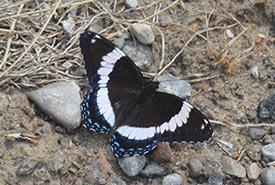
White admiral, Carden Alvar, ON (Photo by NCC)
Volunteering has always played a big role in my life. I’ve participated in my fair share of volunteering for the environment, from tree planting to garbage cleanups. But the butterfly count I attended in late July, an annual Conservation Volunteers (CV) event hosted by the Nature Conservancy of Canada (NCC) at Carden Alvar in Ontario, was unlike anything I have ever participated in. It was a refreshing experience.
Carden Alvar features naturally open habitat that is globally rare and supports many insect, bird and plant species. Within the first five minutes of my arrival at the event, I was beginning to see the complexity of this unique ecosystem, as I saw a variety of unique plant species, an osprey, a turkey vulture and many flying insects, including butterflies and dragonflies.
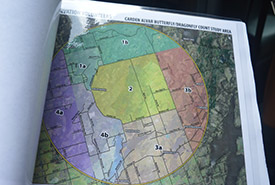
Map of Carden Alvar used for the butterfly count (Photo by NCC)
I was lucky enough to be with a group of individuals who were butterfly pros. They were able to show me the ropes to catching butterflies and help me identify butterfly species, since I was pretty much out of my depth here. Even though we were worried about the forecasted thunderstorm, we were all in high spirits for the day’s events and were hopeful to see many butterfly species.
The key to catching butterflies, as taught to me by Bob Bowles, an avid naturalist, a butterfly expert and our group leader, is to sweep your net among the plants and twist the net once you caught the insect. Twisting the net allows you to trap the insect at the bottom. Bob caught our group’s first butterfly, a monarch, which was soon to be one of the many monarchs we would encounter throughout our day.
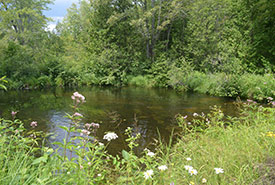
Carden Alvar, ON (Photo by NCC)
My group — Bob, father and daughter duo Ken and Karlene Tuininga, and I — drove down the roads of our designated area while looking out the windows for butterflies. If we saw any we would park on the side of the road, get our nets from the trunk and eagerly search for the butterflies, before we swept our nets to catch the flying insects. After successfully catching a butterfly, we would gather back at the car to identify it, which sometimes required using a field guide for confirmation. While some were easy to identify, others took a bit more work before we could come to a conclusion.
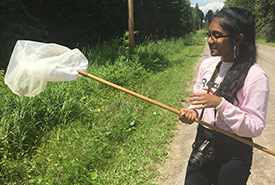
Veshani Sewlall with the monarch she caught (Photo by NCC)
In every different area we went to, I couldn’t help but stand back and admire the natural beauty around me, before I too got in on the action and searched for the flying insects. By the end of the day, I was capable of identifying a few other butterfly species, including aphrodite fritillary and cabbage white. I was ecstatic when I caught a monarch, the only butterfly species I knew prior to the event.
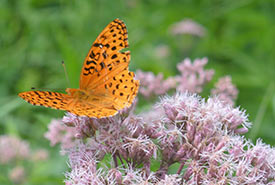
Aphrodite fritillary on milkweed (Photo by NCC)
It was when we were stealthily searching for butterflies that my curiosity piqued and I wanted to know more about butterfly surveys. Bob, who has over 20 years of experience with butterfly counts on the Carden Alvar, was more than happy to share his knowledge.
“The reason we do the butterfly survey is we try to pick the same time of year and same weather conditions, and do a count of all species of butterfly from year to year. We then have records — a database of 30 years — for this particular count," said Bob. "We can now look and see if there are seasonal patterns and changes or if there are territorial range changes, and it really tells us a lot about the environment. Is the habitat getting better or worse? By looking at insects like butterflies and also dragonflies, you can get a pulse on the quality of the habitat.”
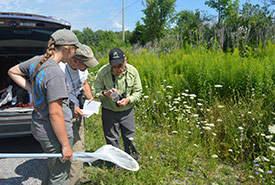
Bob Bowles and Ken and Karlene Tuininga use a field guide to identify butterfly species (Photo by NCC)
Surrounded by butterfly enthusiasts, it was easy to admire and soak up the beauty of these little creatures while having fun. Bob’s enthusiasm for butterflies was infectious, and his knowledge of the landscape was a huge advantage for someone like me, who has never participated in butterfly surveys or visited an alvar before. Ken and Karlene, who both attended past butterfly counts, knew their butterflies and made daring attempts to catch butterflies and dragonflies (we may have gotten a bit sidetracked) that were a bit out of reach.
Our day concluded with tallying how many butterflies we spotted. This year’s butterfly count saw 37 different species of butterflies, with a grand total of 880 individual butterflies counted, of which 302 were counted by my group. Some of the butterflies my group caught included black swallowtail, pearl crescent and white admiral. Interestingly, the butterfly count recorded 154 monarchs, an increase from the 100 counted in 2017 and 50 counted in 2016.
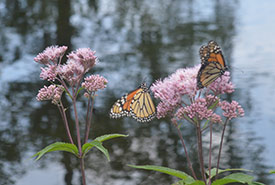
A pair of monarchs resting on spotted joe-pyweed (Photo by NCC)
What was so great about participating in this CV event is it was an immersive learning experience that allowed me to be a part of something so much bigger. To see stewardship work happen in real time is pretty amazing and reinforces the work I do behind the desk as NCC’s summer communications intern.
An increase in monarch individuals, for instance, speaks volumes on the benefits of NCC’s ongoing stewardship efforts on the Carden Alvar, and is a reminder that there is still more to be done to conserve habitats and the species they sustain.
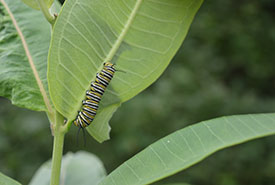
A monarch larva on milkweed (Photo by NCC)
From checking the leaves of milkweed for monarch larvae to pursuing butterflies as they fluttered among flowers, without a doubt, the day was eventful. While I cannot say I am an expert, I definitely believe I earned my beginner’s badge in netting and identifying butterflies. All I know for certain is this is only the beginning for me. I plan to attend many more CV events in the future.
The Conservation Internship Program is funded in part by the Government of Canada’s Summer Work Experience program.


